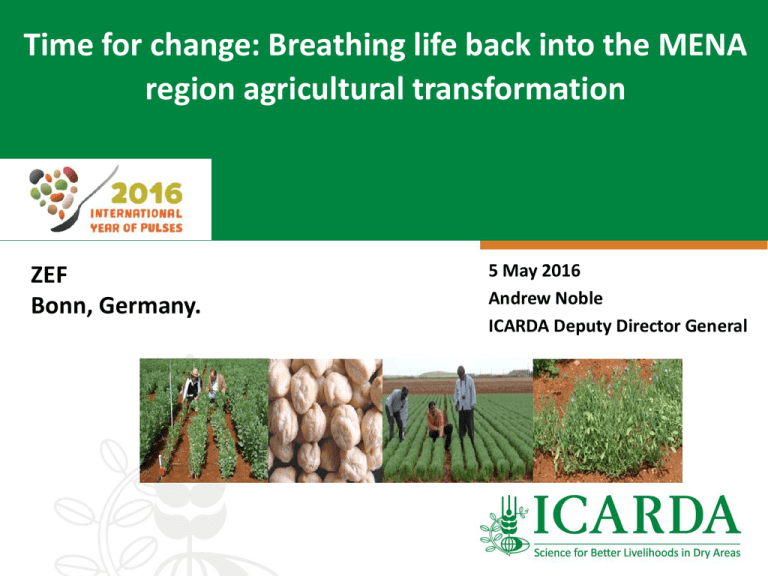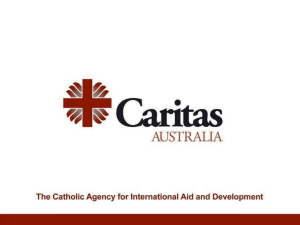Time for change: Breathing life back into the MENA ZEF Bonn, Germany.
advertisement

Time for change: Breathing life back into the MENA region agricultural transformation ZEF Bonn, Germany. 5 May 2016 Andrew Noble ICARDA Deputy Director General Presentation Outline • The challenges facing MENA. • Addressing the challenges through an agricultural lens – examples of interventions. • Concluding remarks. 1 The challenges facing the MENA Region • Population growth. • Rapid and uncontrolled urbanization. • High rates of unemployment. • Weak institutions and political systems in transition – failed and fragile states. • Disenfranchised rural communities – predominantly agrarian economies. • Climate Change and Resource Constraints (water)! 2 A general sense of disappear. Water Use in MENA Region Actual Renewable Water Resources (ARWR) per capita 35 Australia/New Zealand MENA the world’s most waterscarce region 34.5 Latin America & Caribbean 20.3 North America Region • 13 Europe & Central Asia Sub-Saharan Africa 8 East Asia & Pacific (& Japan & Koreas) 5.6 Western Europe 5.4 South Asia • Highest water withdrawal is in MENA 2.7 Middle East & North Africa 1.1 0 10 20 30 40 ARWR per capita (1000m 3/yr) Total renewable water resources withdrawn (%) On-farm water use efficiency is as low as 40%, suggesting over-irrigation of scarce resource 72.7 South Asia 25.1 Western Europe 10.3 East Asia & Pacific (& Japan & Koreas) 9.4 North America Region • Middle East & North Africa 8 Europe & Central Asia 6.2 Australia/New Zealand 3.2 Sub-Saharan Africa 2.2 Latin America & Caribbean 1.4 0 Percent of total renewable water resources withdrawn 10 20 30 40 Percent 50 60 70 80 Increased dependency on imports for food security Global Trade: Net cereal imports (in million MT) by region, 2010 Safety nets/social protection systems are challenged by food price shocks. Former Soviet Union +16.1 +91.2 +17.5 Europe North America -58.8 -65.8 Asia -18.0 MENA Region +6.3 Latin America and the Caribbean Sources: adapted from USDA 2011 Sub-Saharan Africa Oceania +18.6 + - Net Exports Net Imports Pulses deficit regions Global pulse trade at present: almost 12 million tons in Million MT by region (2011) Relative change of mean annual precipitation 1980/1999 to 2080/2099 Relative change of mean annual precipitation 1980/1999 to 2080/2099, scenario A1b, average of 21 GCMs (compiled by GIS Unit ICARDA, based on partial maps in Christensen et al., 2007) Addressing the Challenges of Food Security in MENA While it is possible to reduce spending on imports by reducing waste in supply chains, trying to import much less by producing much more is likely to be too costly for most countries. Jobbins and Henley, 2015. Is this statement true? 7 Envisaging Solutions: Crop Yield Potential for Rainfed Wheat Environmental conditions in MENA limit the potential to grow food – is this correct? Crop Yield Potential F3: GSP-110*20 8 The Syrian Case – Cause for cautious optimism Impact of Science, Technology formerly and wheat Enabling Policy Environment in Syria Syria, a importer became selfsufficient in wheat production – and eventually a wheat exporter. A combination of new high-yielding varieties, supplemental irrigation, inputs of fertilizers & herbicides and supportive Government policies. Impact of the Sustainable Intensification on Wheat Production in Syria Wheat Production in Syria Impact of(Thousand the Sustainable Intensification Tons) on Wheat Production in Syria 6000 Drought started in Syria in 2008 5000 4000 3000 2000 1000 10 2014 2012 2010 2008 2006 2004 2002 2000 1998 1996 1994 1992 1990 1988 1986 1984 1982 1980 1978 1976 1974 1972 1970 1968 1966 0 1. Conservation Agriculture: Approach to Coping with Climate Change • Minimum soil disturbance stubble retention • Direct seeding (affordable machinery) Benefits • Savings in time, energy (fuel), machinery wear • Benefits soil structure and Moisture • Timely sowing • Higher yield potential • less soil erosion 11 Local fabrication of zero-tillage seeders: Part of the solution Imported seeders Price: US$ 30,000 to $60,000 Amazon – imported Syria-El Bab - local Syria-Kamishley - local Locally manufactured seeders (Iraq, Syria, Morocco) Price: US$ 1500 to 6000 12 To scale out – need for service providers Opportunities for the emergence for new business models to service the sector. Seeder training Erbil 2013 13 Mean yield early ZT vs late CT over four years in Syria Mean Grain Yield kg/ha 3,000 18% 20% 12% 15% CT Late ZT Early 2,500 2,000 1,500 1,000 500 0 Wheat Chickpea 2008/09 – 2011/12 14 Barley Lentil Adoption 2005 to 2011 Significant business opportunities for Manufacturing and Service Sectors 800 Iraq area Syria area Iraq farmers Syria farmers 14000 12000 700 600 10000 500 8000 400 6000 300 4000 200 2000 100 0 Number of farmers Area of all winter crops (ha) 16000 0 2006-07 2007-08 2008-09 2009-10 Cropping season 2010-11 70-80% of area was true adoption, where farmers owned/rented/borrowed a ZT seeder 15 2. Productuve and Sustainable Rangeland - Governance • The key to sustainable management of communal rangelands is developing socially acceptable institutional arrangements • Developing in Tunisia a specific pastoral code for managing collective rangelands • Local self-governance systems (Himas) can act as innovation platforms for ecological sustainability, social fairness and economic growth 2500 Biomass (kg DM/ha) 2135 2000 1500 1000 500 0 236 Unprotected rangelandControl area 16 Rested area under local governance Rest Sustainable development of landscape depressions in pastoral ecosystems 1000 800 2 Density (Plants/m) 900 Density 28 fold 700 600 500 400 300 200 100 0 Protected Grazed Biomass (kg/h) 2500 Biomass 5 fold 2000 1500 1000 500 0 Protected Grazed Impact of 2 years protection Water Harvesting in Marginal Land Agro-Ecosystem • Micro-catchments mechanized contour laser planting • Effective water harvesting • Grazing management • 40-50% increase in rainwater productivity Options for crop-livestock integration in cereal-based rainfed systems Atriplex species in Alley-cropping systems with cereals Alley cropping Benefits: • Provides fodder in times of scarcity. • Provides rich and diverse diet for livestock. • Reduces the need for chemical fertilizers and improves soil fertility. • Reduces erosion in irrigated and rainfed areas. 19 Cactus – a dryland multi-purpose plant Advantages of cactus: • Drought tolerant • Evergreen habit • Easy to establish, to maintain & to use • Multipurpose use • Fodder potential • Resolve livestock watering • High palatability & high in soluble carbohydrates • Introduction of cactus pear to several countries including Tunisia, Jordan, Syria, India and Pakistan. • Promising and well adapted accessions are being disseminated to farmers. 20 Sustainable rangeland management contributes to increasing incomes Technologies for improved yoghurt & cheese processing Problems: Eye formation Sourness and/or off flavor Risk of Brucellosis Solutions: Milk pasteurization prior to cheese making Use of thermometers for right temperature for pasteurization The benefits: Hygiene & high quality product reducing risks to transmission of diseases Improved marketability and increased net income Establishing small cheese making enterprises – potential markets into Europe Non-Traditional Sources of Feed: Feed Blocks Improved feeding management • increasing feed use efficiency by balancing diets for protein and energy • Provide sources of feed during the dry season Better utilization of crop byproducts • e.g. urea treated straw: wheat straw reaches the quality of lentil straw Better utilization of agro-industry by-products • e.g. sugar beet pulp, cotton seed cake, molasses, tomato pulps, olive leaves and cake, etc. • e.g. feed blocks as one technical option to produce homogenous mixtures 22 Integrated Livestock/Rangelands/Crops Production Systems Successful Technologies By-products - feed blocks On-farm feed production Flock management Cactus & fodder shrubs Barley production Natural pastures & rangeland management 3. Raised-Bed Planting in Irrigated Systems Advantages of moving to raised bed technologies FP: furrows irrigation FlP: flat bed irrigation RBP: raised bed irrigation Raised-bed wheat improvement package –Egypt Reduce applied water by 30% Increased yields by 25% Reduced seed rate by 50% Increased WUE by 72% 70,000 feddan in Egypt in two years Egyptian government investing $1.7 million in promoting. Cannot keep up with demand. 4. Breeding Crops for Drought Tolerance and WUE Example: Synthetic wheat, tolerance to heat and drought Parent Variety Yield t/ha % recurrent parent Cham 6*2/SW2 1.6 147 Cham 6*2/SW2 1.5 138 Cham-6 1.10 100 Attila-7 1.3 - Yield of “synthetic derivatives” compared to parents under drought stress. (Tel Hadya 2008 -- 211 mm) Genetic Adaptation: Heat and Drought Tolerance of Wheat New varieties developed with management packages Hub countries: 15 varieties released to farmers : 4 released in 2014 11 candidates in 2015 Merits: Highly adapted, heat tolerant, good quality, disease resistant with yields of 5-7t/ha Ethiopia: - 2 released in 2014 - 3 candidates in 2015 check Improved 8 6 Sudan - 6 candidates in 2015 4 2 0 Nigeria: Ethiopia Sudan 28 Nigeria - 2 released in 2014 - 2 candidates in 2015 Breeding for enhancing Water Productivity by changing the cropping season Winter vs. Spring Chickpea in West Asia & North Africa The biggest challenge is seed delivery systems – opportunities for young entrepreneurs Spring sown crop Mature winter crop Concluding Remarks Agriculture in MENA is and will be the dominant employer and contributing element to GDP; it is a neglect sector in these economies; We can reduce the need for food imports by transforming the agricultural sector – it part of the solution to a ‘wicked problem’. There are significant opportunities in developing business models to support local manufacturing, service providers and added value; MENA contains productive agro-ecosystems and provides significant opportunities for sustainable development. How we manage them will be key to living with future climates. Thank you






